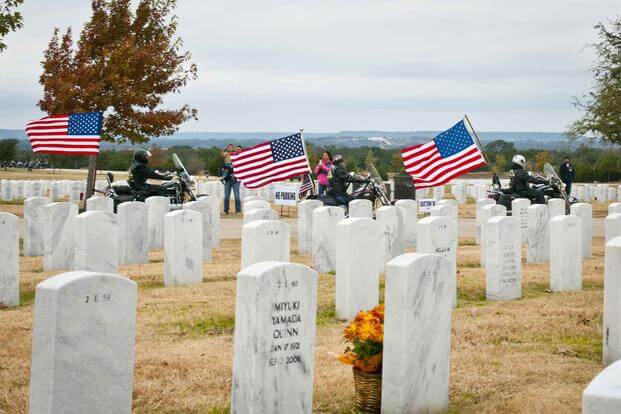To meet its goal to ensure that nearly all former service members can be buried in a veterans cemetery close to home, the Department of Veterans Affairs is relying on states, U.S. territories and tribal nations to contribute space, funding and oversight, with a little help from the VA.
The department has set an objective to provide burial space within a 75-mile radius for 95% of the nation's veterans. Currently just shy of that goal at 94%, the department needs assistance from regional, non-federal cemeteries, a VA official said last week.
"The only way we're going to get there, frankly, is ... going to be in partnership with the states," said VA Under Secretary for Memorial Affairs Matthew Quinn during a press call with reporters March 28.
Read Next: Air Force Will Allow More Body Fat for Recruits as Service Struggles to Find New Airmen
The VA operates 155 national cemeteries and has provided grants to 122 veteran cemeteries run by states, U.S. territories and Native American tribes. The department announced last month that it had awarded its billionth dollar in grant funding to these cemeteries after providing nearly $1.9 million to North Dakota to expand that state's veterans cemetery in Mandan.
Since the start of the program in 1978, the VA has helped provide more than 800,000 interment sites for U.S. veterans.
To reach its 95% goal, the VA needs roughly 200,000 more sites, largely in rural areas. According to Quinn, building a national cemetery in locations that have fewer veterans doesn't make sense.
Instead, helping states like Michigan, Texas and Nebraska, which all are considering establishing new veterans cemeteries, would help.
"We do give the states the map of, and the chart of, the veterans served in each area. So we'll continue to do that," Quinn said.
Veterans buried in non-federal facilities receive the same burial and memorial benefits as those enshrined in VA national cemeteries, according to Quinn. Those benefits include a gravesite; opening and closing of the grave; perpetual care of the site; a headstone or marker; burial flag; and certificate.
"My father, brother and two uncles are interred in the state of Montana grant-funded veterans cemetery, and I knew no difference. All I knew is that their grave sites were national shrines and would be cared for in perpetuity," Quinn said.
The VA's fiscal 2024 budget requests $835 million for the National Cemetery Administration, an increase of 7.5% from current levels. The proposed budget includes $60 million for the cemetery grant program, up from $50 million in fiscal 2023.
Without including the state, regional and tribal cemeteries, just 77% of the nation's 16.5 million veterans would have access to a VA cemetery within 75 miles of where they live, Quinn said, calling that an "an unacceptable number."
"That shows you the importance of this valuable cooperative program," he added.
-- Patricia Kime can be reached at Patricia.Kime@Military.com. Follow her on Twitter @patriciakime
Related: 4 New Burial Sites with Capacity for More Than 300,000 Veterans and Their Families Part of VA Plans












